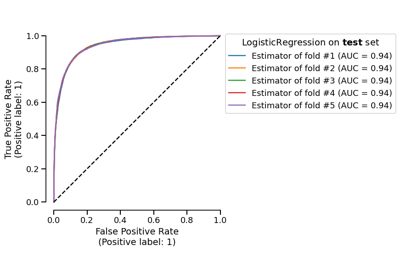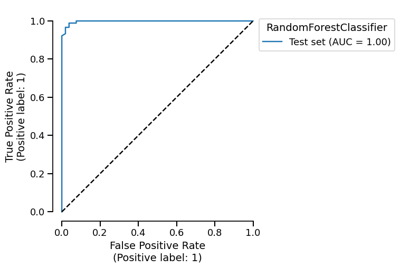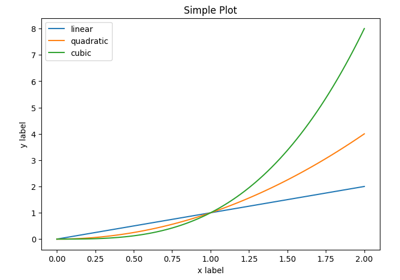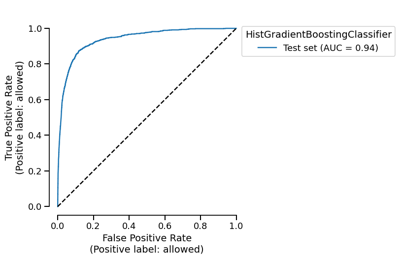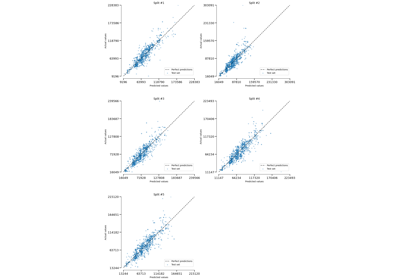CrossValidationReport#
- class skore.CrossValidationReport(estimator, X, y=None, cv_splitter=None, n_jobs=None)[source]#
Report for cross-validation results.
Upon initialization,
CrossValidationReportwill cloneestimatoraccording tocv_splitterand fit the generated estimators. The fitting is done in parallel, and can be interrupted: the estimators that have been fitted can be accessed even if the full cross-validation process did not complete. In particular,KeyboardInterruptexceptions are swallowed and will only interrupt the cross-validation process, rather than the entire program.- Parameters:
- estimatorestimator object
Estimator to make the cross-validation report from.
- X{array-like, sparse matrix} of shape (n_samples, n_features)
The data to fit. Can be for example a list, or an array.
- yarray-like of shape (n_samples,) or (n_samples, n_outputs), default=None
The target variable to try to predict in the case of supervised learning.
- cv_splitterint, cross-validation generator or an iterable, default=5
Determines the cross-validation splitting strategy. Possible inputs for
cv_splitterare:int, to specify the number of folds in a
(Stratified)KFold,a scikit-learn CV splitter,
An iterable yielding (train, test) splits as arrays of indices.
For int/None inputs, if the estimator is a classifier and
yis either binary or multiclass,StratifiedKFoldis used. In all other cases,KFoldis used. These splitters are instantiated withshuffle=Falseso the splits will be the same across calls.Refer to scikit-learn’s User Guide for the various cross-validation strategies that can be used here.
- n_jobsint, default=None
Number of jobs to run in parallel. Training the estimator and computing the score are parallelized over the cross-validation splits. When accessing some methods of the
CrossValidationReport, then_jobsparameter is used to parallelize the computation.Nonemeans 1 unless in ajoblib.parallel_backendcontext.-1means using all processors.
- Attributes:
- estimator_estimator object
The cloned or copied estimator.
- estimator_name_str
The name of the estimator.
- estimator_reports_list of EstimatorReport
The estimator reports for each split.
See also
skore.EstimatorReportReport for a fitted estimator.
Examples
>>> from sklearn.datasets import make_classification >>> from sklearn.linear_model import LogisticRegression >>> X, y = make_classification(random_state=42) >>> estimator = LogisticRegression() >>> from skore import CrossValidationReport >>> report = CrossValidationReport(estimator, X=X, y=y, cv_splitter=2)
- cache_predictions(response_methods='auto', n_jobs=None)[source]#
Cache the predictions for sub-estimators reports.
- Parameters:
- response_methods{“auto”, “predict”, “predict_proba”, “decision_function”}, default=”auto
The methods to use to compute the predictions.
- n_jobsint, default=None
The number of jobs to run in parallel. If
None, we use then_jobsparameter when initializingCrossValidationReport.
Examples
>>> from sklearn.datasets import load_breast_cancer >>> from sklearn.linear_model import LogisticRegression >>> from skore import CrossValidationReport >>> X, y = load_breast_cancer(return_X_y=True) >>> classifier = LogisticRegression(max_iter=10_000) >>> report = CrossValidationReport(classifier, X=X, y=y, cv_splitter=2) >>> report.cache_predictions() >>> report._cache {...}
- clear_cache()[source]#
Clear the cache.
Examples
>>> from sklearn.datasets import load_breast_cancer >>> from sklearn.linear_model import LogisticRegression >>> from skore import CrossValidationReport >>> X, y = load_breast_cancer(return_X_y=True) >>> classifier = LogisticRegression(max_iter=10_000) >>> report = CrossValidationReport(classifier, X=X, y=y, cv_splitter=2) >>> report.cache_predictions() >>> report.clear_cache() >>> report._cache {}
- get_predictions(*, data_source, response_method, X=None, pos_label=None)[source]#
Get estimator’s predictions.
This method has the advantage to reload from the cache if the predictions were already computed in a previous call.
- Parameters:
- data_source{“test”, “train”}, default=”test”
The data source to use.
“test” : use the test set provided when creating the report.
“train” : use the train set provided when creating the report.
“X_y” : use the train set provided when creating the report and the target variable.
- response_method{“predict”, “predict_proba”, “decision_function”}
The response method to use.
- Xarray-like of shape (n_samples, n_features), optional
When
data_sourceis “X_y”, the input features on which to compute the response method.- pos_labelint, float, bool or str, default=None
The positive class when it comes to binary classification. When
response_method="predict_proba", it will select the column corresponding to the positive class. Whenresponse_method="decision_function", it will negate the decision function ifpos_labelis different fromestimator.classes_[1].
- Returns:
- list of np.ndarray of shape (n_samples,) or (n_samples, n_classes)
The predictions for each cross-validation split.
- Raises:
- ValueError
If the data source is invalid.
Examples
>>> from sklearn.datasets import make_classification >>> from sklearn.linear_model import LogisticRegression >>> X, y = make_classification(random_state=42) >>> estimator = LogisticRegression() >>> from skore import CrossValidationReport >>> report = CrossValidationReport(estimator, X=X, y=y, cv_splitter=2) >>> predictions = report.get_predictions( ... data_source="test", response_method="predict" ... ) >>> print([split_predictions.shape for split_predictions in predictions]) [(50,), (50,)]
